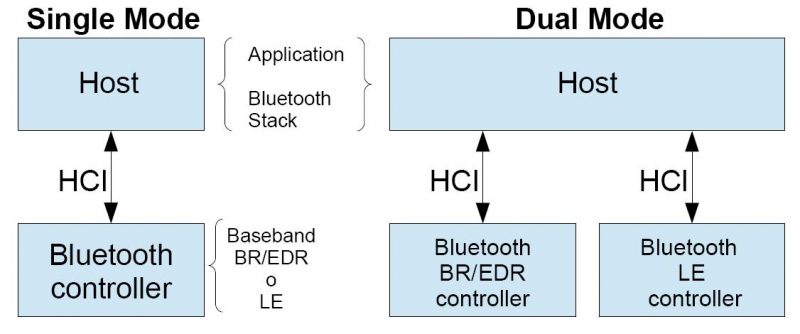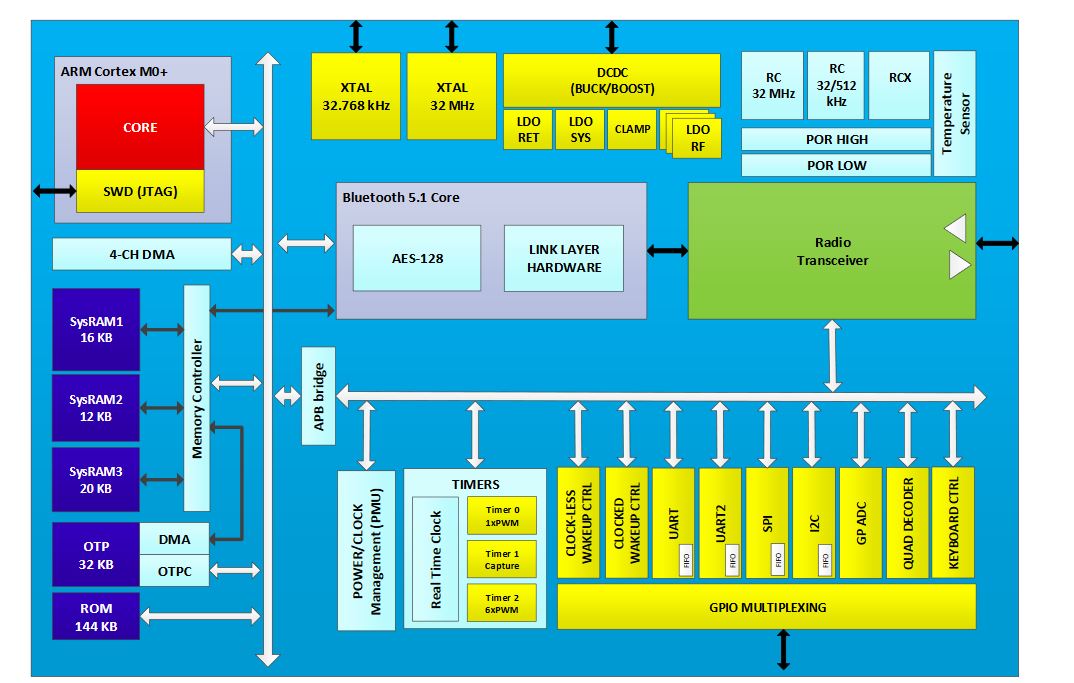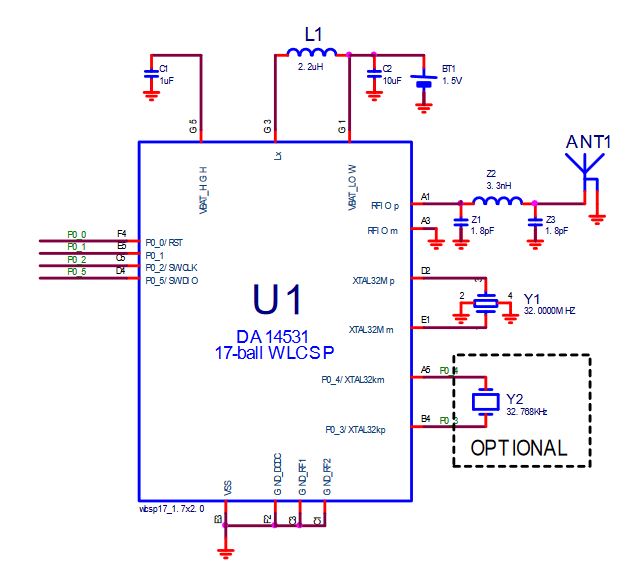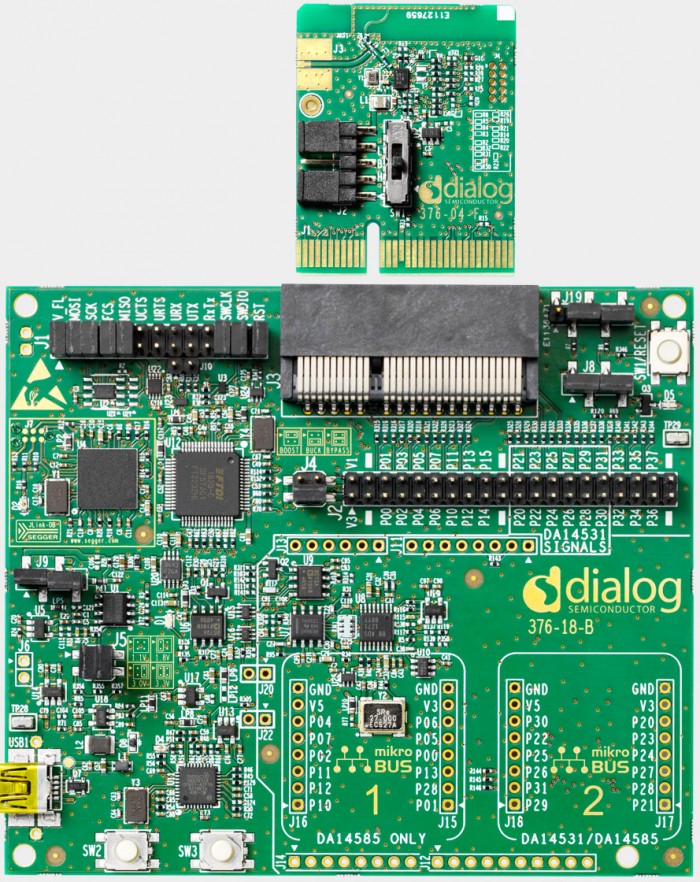By Maurizio Di Paolo Emilio, editor, Power Electronics News
Bluetooth Low Energy has played a pivotal role in the IoT revolution — particularly for short-range wireless communication in devices in which battery life is critical. The advent of fitness trackers and smartwatches has further driven the Bluetooth market.
A Bluetooth device (Fig. 1 ) consists of a host and controller. The Bluetooth stack and the current application are performed on the host, while baseband operations take place on the controller, which supports either classic Bluetooth (BR/ EDR) or low consumption (BLE). Both communicate via the host-controller interface (HCI).

Fig 1: Block diagram of the Bluetooth single-mode and dual-mode architecture.
BLE is the designation used for the special extensions that started with version 4. The 4.1 and 4.2 versions have provided minor improvements, but it is with version 5 that the major updates arrived with a high data rate and low-power consumption.
Bluetooth 5 was announced in the second half of 2016, touting a transfer speed of 2 MB/s, a coverage range of 240 meters, and reduced energy consumption. But these developments were still not enough to keep up with next-generation wireless connectivity.
Thus, the same Special Interest Group (SIG) Bluetooth announced specifications for the new Bluetooth 5.1 around the end of 2018. The most important innovation is the ability of Bluetooth 5.1 to also work as a locator, with a degree of accuracy of a few meters. The Bluetooth 5.1 spec offers two different methods to identify the position of the devices within the space: angle of arrival (AoA) and angle of departure (AoD).
Today most wearables devices work with Bluetooth Low Energy. This technology is considered a low-cost solution requiring very little energy. The product can be powered by a small battery for months or even years in some cases. Dialog Semiconductor has introduced what it defines as the smallest and most energy-efficient Bluetooth 5.1 SoC, the DA14531. The accompanying new module also simplifies the development of Bluetooth products and allows for wider adoption possibilities for IoT applications.
The SmartBond TINY chip is based on the 32-bit ARM Cortex M0 + core with integrated memories and a complete set of analog and digital peripherals. Its implementation aims to solve the problems of increasing costs for IoT device designs by allowing a reduction in the overall size of the system while maintaining high performance. Dialog designed the SoC to lower the costs of adding BLE functionality to as low as $0.50 in high volumes.
The small size makes the SoC suitable for any space-constrained design, such as electronic styluses, shelf labels, beacons, or active RFID tags for asset tracking. The SoC also can be used in applications that require provisioning, such as cameras, printers, and wireless routers.
The DA14531 also extends wireless connectivity to applications in the connected medical field. Examples include inhalers, medicine dispensers, scales, thermometers, and glucometers. (Fig. 2 ).

Fig 2: Block diagram of the DA14531.
Housed in packages as small as 2.0 x 1.7 mm, the SmartBond Tiny is about half the size of its predecessors, according to Dialog. The SoC requires only six external components, a single clock source, and a power supply to create a complete low-energy Bluetooth system (Fig. 3 ). This allows developers to adapt the chip to almost any RF resource monitoring design.
“The external components are really limited, so two capacitors are required. The power inductor can be skipped under certain conditions,” said Adrie Van Meijeren, product marketing manager Americas, Bluetooth Low Energy, at Dialog Semiconductor.

Fig. 3: Alkaline battery cell powered system diagram — boost configuration.
The module ensures long life and durability, even with small batteries, and allows customers to take advantage of the new architecture as part of product development, rather than having to certify their platforms, thus saving time, development efforts and costs. The DA14531's built-in DC/DC converter allows for a wide operating voltage from 1.1 V to 3.3 V.
“Regarding batteries and the DC/DC converter, we can work with any kind of 1.4-V/1.5-volt battery next to 3-V batteries like coin cell batteries. And because we have that boost converter integrated onboard, that gives a cost savings. The efficiency for the DC/DC depends a little bit on the quality of your inductor, but you can get around 85% efficiency,” said Van Meijeren.
“The DC/DC feature is important, especially for disposable batteries. These disposable batteries, very often, have a very tiny capacity, like 15 milliampere-hour. And if the DC/DC converter is starting, there is a peak current charging the inductor and the capacitors, and we do have a current limiter you can set between 6 mA and 96 mA, and that allows us to start with any battery, whatever the condition,” he added.
With the low-power consumption of Bluetooth Low Energy, applications can work on a small battery for four or five years. This is vital for applications that only need a periodical exchange of small amounts of data.
Dialog also offers the DA14531 SmartBond TINY Development Kit, which integrates the DA14531 Bluetooth Low Energy SoC. Thanks to two mikroBUS header interfaces and one Arduino interface, the system offers expanded functionality (Fig. 4 ).

Fig. 4: DA14531 SmartBond TINY Development Kit Pro.
Currently used by around 8.2 billion devices worldwide, from smartphones to laptops, Bluetooth is the main player in our everyday technological life. Cisco has predicted that over 50 billion of these smart devices will be in use by 2020, with Bluetooth SIG supporting up to a third of these devices.
With billions of BLE-enabled smart devices on the market, the list of applications for this protocol is unlimited. For the selection of the BLE, it is necessary to take into consideration a series of attributes: form factor, electrical specifications, desired functionality, software development tools, and technical support.
Advertisement
Learn more about Electronic Products Magazine





